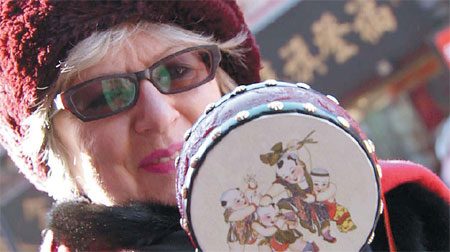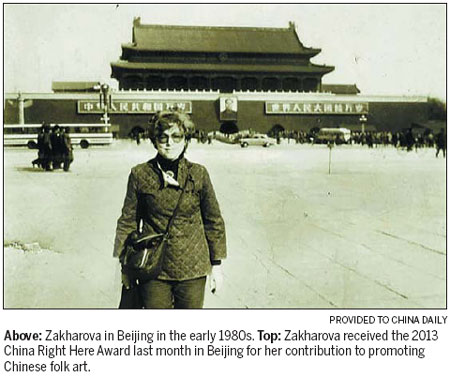
She went to China years ago and grew to love the country's folk art
A large part of Irina Zakharova's life is associated with toys, children and art. She has a doctorate in classical art and art theory from Lomonosov Moscow State University, the most prestigious university in Russia, and started work at the Pushkin State Museum of Fine Arts soon after graduating in 1977.
Four years later, her husband was appointed cultural counselor to China, and Zakharova moved to Beijing with him and their daughter.
Growing up when China and the Soviet Union had a very close relationship, Zakharova was as interested in China as she was curious. But she was also reluctant to leave her job at the museum, which she loved. "It's not a job," she says. "It's my life."
Happily, she soon found a way to continue her artistic pursuit and museum work during her stay in China.
Soon after the family arrived, Zakharova remembers that her daughter received a birthday gift from a Chinese friend, a folk toy of a boy sitting on a fish.
"Why is he sitting on a fish?" her daughter had asked.
"The question brought me back to my childhood in the 1950s," says Zakharova, now in her 60s. "I saw a lot of Chinese folk art at that time, and I had been puzzled, too."
After asking her Chinese friends, Zakharova found out that one word for fish in Chinese sounds like another word meaning abundance, so the fish has come to represent hopes for affluence.
Zakharova soon realized the richness of Chinese traditional culture behind folk toys and started collecting them. Now she often organizes touring exhibitions of her toys, and through that has become an advocate of Chinese traditional culture.
Her toys - she has more than 5,000 - have been exhibited not only in Russia, but also in other member countries of the Shanghai Cooperation Organization, including Kazakhstan, Kyrgyzstan, Tajikistan and Uzbekistan.
In recent years, her efforts have expanded to organizing art exhibitions centering on the exchange and inheritance of folk culture through children's collaboration and creativities among the SCO countries.
"Collecting Chinese folk toys became part of my life," says Zakharova, who would hunt down local traditional toys wherever she traveled in China in the 1980s.
Her collection includes all genres, such as rattle-drum, clay figurine, paper-cut and traditional lunar New Year's paintings.
"I study while I collect, because I think without studying the culture behind those toys, the process of collecting is incomplete. For me the most important thing is not finding the oldest toy, but finding contemporary folk toys which preserve traditions."
It is not easy for a Westerner to understand Chinese traditions, and Zakharova says she was at a loss initially.
"A fish is the symbol of affluence, and peach represents longevity. A rat is a horrible creature for Europeans, but here it is one of the most auspicious Chinese zodiac signs."
Every province in China has its particular toys embedded with local tradition, such as the ninigou, literally muddy dog, in Huaiyang county, Henan province.
Moreover, some folk toys are associated with Chinese mythology, such as Fu Xi and Nyu Wa, who were the first gods to come out of chaos. Nyu Wa, with her human body and serpent tail, is the mother creator.
"Learning all this, on one hand, is interesting, but on the other hand it is very complicated for me," Zakharova says. "However, little by little I have discovered that there are common themes in Chinese and Western cultures.
"Two figures standing by each other usually implies love, two butterflies dancing in the air is about the story of Liang Shanbo and Zhu Yingtai, which can be compared with the classical love story of Romeo and Juliet."
Zakharova speaks little Chinese, but she knows a lot of famous Chinese folk art craftsmen, collectors and researchers.
Meeting the late Li Cunsong, a well-known Chinese folk toy collector, played an important role in making Zakharova decide to collect folk toys.
"We met at a folk art exhibition in 1982," Zakharova recalls, and says she had no worries communicating because "the art does not need to be translated".
Li, an expert on Chinese folk toys and an author of three books on the subject, gave Zakharova valuable help and suggestions.
"He was a real master, and getting to know him was the most important event in my life."
After eight years collecting folk toys, Zakharova organized a Chinese Folk Toy Fair at the Pushkin State Museum of Fine Arts in Moscow in 1988. Over six weeks, the exhibition attracted more than 10,000 visitors
Zakharova remembers a message left by a boy who attended the exhibition, saying he would like to do whatever was needed to please the pot-bellied smiling grandfather of longevity. He said he liked it so much that he would be glad to take it with him wherever he went, even in class.
"Through the exhibition, Russian people get to know Chinese culture in a playful way."
The success of the exhibition encouraged Zakharova. In the following decades, she went on to publish the book My Chinese Toy, recalling each piece of toy she had collected.
"Each toy is a unique encounter," she says.
In 2005, Zakharova and her husband Vladimir Zakharov, then the deputy secretary-general of the Shanghai Cooperation Organization, initiated an arts event and exhibition titled "Children Draw Fairy Tales".
The project, aimed at promoting understanding between young people in SCO countries, invited children to read fairy tales of another country and retell the tales through drawings that would be featured in the exhibition.
Over the past eight years, the project has toured a total of 18 cities in SCO member states, including Astana, Bishkek, Dushanbe, Moscow and Tashkent.
"There was a very cold evening in the winter, and I had to bring bags full of folk toys to one school. I was so cold and tired that I couldn't help asking myself why, but then before I had entered the classroom I heard the children cry out 'Oh, the Chinese folk toys are coming', and I felt so happy at the moment. They were waiting for me, for the toys.
"Children are the future, and the future of the world depends on how we foster our children."
Zakharova says the significance of the project is that such cultural exchanges help promote better understanding among children and promote a more peaceful world.
In 2008, Zakharova published her second book about China, written with her husband in a cheerful and playful tone, introducing the history, culture and folk art of China.
"Most of the previous projects would have been impossible without the support from my family. The program we organized and all the books we wrote are the common interest of my family, my husband, my daughter and me," says Zakharova, who is now a senior associate with the aesthetic education center Museyon at Pushkin State Museum of Fine Arts.
"It is very important for a family to have a shared interest."
sundayed@chinadaily.com.cn


(China Daily Africa Weekly 12/06/2013 page28)
